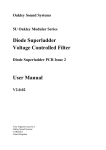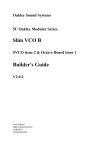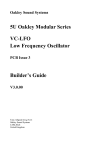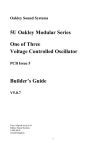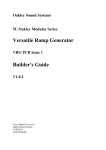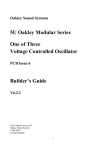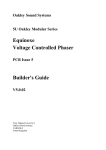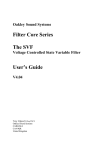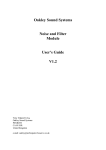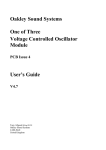Download TSL-3 Builder`s Guide - Oakley Sound Systems
Transcript
Oakley Sound Systems 5U Oakley Modular Series TSL - Transistor Superladder Voltage Controlled Filter PCB Issue 3 Builder's Guide V3.0.2 Tony Allgood Oakley Sound Systems CARLISLE United Kingdom Introduction This is the Project Builder's Guide for the issue 3 Transistor Superladder 5U module from Oakley Sound. This document contains a basic introduction to the board, a full parts list for the components needed to populate the boards, a list of the various interconnections and a 'how it works' section. For the User Manual, which contains an overview of the operation of the unit, the history of the various board issues, and the calibration procedure, please visit the main project webpage at: http://www.oakleysound.com/super.htm Please note that this is not the Builder's Guide for the original issue 3 Superladder. The SL-3 and the TSL-3 are two very different projects. For general information regarding where to get parts and suggested part numbers please see our useful Parts Guide at the project webpage or http://www.oakleysound.com/parts.pdf. For general information on how to build our modules, including circuit board population, mounting front panel components and making up board interconnects please see our generic Construction Guide at the project webpage or http://www.oakleysound.com/construct.pdf. 2 The Transistor Superladder PCB The issue 3 Transistor Superladder behind a natural finish Schaeffer panel. Note the optional Sock4 board which makes wiring the four sockets simple. I have provided space for the four main control pots on the PCB. If you use the specified pots and brackets, the PCB can be held firmly to the panel without any additional mounting procedures. The pot spacing is 1.625” and is the same as the vertical spacing on the MOTM modular synthesiser. The pots are; cut off frequency, resonance, resonance CV depth and filter ‘shape’. The design requires plus and minus 15V supplies. These should be adequately regulated. The current consumption is about 40mA for each rail. Power is routed onto the PCB by a four way 0.156” Molex type connector. You could, of course, wire up the board by soldering on wires directly. The four pins are +15V, ground, earth/panel ground, -15V. The earth connection allows you to connect the metal front panel to the power supply’s ground without it sharing the modules’ ground line. More about this later. The PCB has four mounting holes for M3 bolts, one near each corner. These are not required if you are using the pot brackets. 3 Buffered or Unbuffered Option The issue 3 board allows the choice to send the feedback signal through a Darlington buffer circuit before re-entering the ladder at the bottom. The Darlington buffer or voltage follower circuit is part of the LM13700 the TSL uses to control the feedback. However, in earlier versions of the Superladder this was not used. TSL-3 allows the PCB to be built to either use the buffer and drive the ladder with a voltage, or not use the buffer and to drive the ladder directly via the OTA's current output. The sonic differences are fairly minimal but the buffer does introduce some small amount of non linearity or distortion to the feedback signal. This should give a slight change in the sound when the filter is used with a large input signal and with the filter at high resonance. I'll leave it up to you as to which one you should build but you may wish to try both and see which one you like the best. It is not easily possible to change modes on the fly so the board will probably built in one mode or the other. The mode is selected by placement of a wire link and the choice of three resistors and one capacitor. The actual details are given in the parts list. This one has been made in the standard 'unbuffered' option. Note that pins 2 and 3 of LK1 have been linked and R69, R70 and C27 are not fitted. 4 Transistor Superladder issue 3 Parts List For general information regarding where to get parts and suggested part numbers please see our useful Parts Guide at the project webpage or http://www.oakleysound.com/parts.pdf. The components are grouped into values, the order of the component names is of no particular consequence. A quick note on European part descriptions. R is shorthand for ohm. K is shorthand for kiloohm. R is shorthand for ohm. So 22R is 22 ohm, 1K5 is 1,500 ohms or 1.5 kilohms. For capacitors: 1uF = one microfarad = 1000nF = one thousand nanofarad. To prevent loss of the small ‘.’ as the decimal point, a convention of inserting the unit in its place is used. eg. 4R7 is a 4.7 ohm, 4K7 is a 4700 ohm resistor, 6n8 is a 6.8 nF capacitor. The 'Buffered' and 'Unbuffered' Option A small wire link should be fitted in LK1. Link out pin 1, the square pad, with the middle pin, for the buffered version. Link out pin 3, the end round pad, with the middle pin, for the unbuffered version. Resistors 1% 0.25W metal film types are to be recommended. However, 5% ones can be used in all places except those marked '1%' which have to be 1% or better. R37 will be 5% since finding these in 1% is not easy and is this particular case not worthwhile. Components marked with a * are only to be fitted if building the full 3U version. For those building the 1U filter core version you should not fit these parts. 330R 680R 1% 1K 1K 1% 1K5 2K2 3K3 4K7 1% 10K 15K 22K 22K 1% 27K 1% R27, R28, R24, R19 R56 R2, R6, R8, R7, R30, R5 R52 R11 R59, R41, R45 R25, R4, R3 R61, R63, R47, R49 R58, R32, R29, R15 R55, R38, R14 R35, R51, R1, R23 R46, R48, R43, R53, R60, R62, R57, R67 R64 5 33K 47K 47K 1% 68K 100K 100K 1% 120K 220K 270K 390K 750K 1% 3M3 R22 R16, R21 R54 R31, R42 R10, R33, R9, R17, R68*, R39*, R18*, R12*, R13* R40* R26 R44 R50 R36, R20 R66 R37 1K +3000ppm/K PTC R65 And if building the unbuffered option: 1K R34 And if building the buffered option: 10K 47K 33K R69 R70 R34 Capacitors 100nF multilayer ceramic C14, C15, C16, C24, C5, C21, C22, C6, C20, C19, C4, C3 100pF C0G 2.5mm ceramic C13, C25 33nF, 100V polyester 1uF, 63V polyester C7, C8, C9, C10 C23, C26, C12, C2 2u2, 63V electrolytic 220uF, 16V electrolytic C11, C17, C18 C1 And if building the buffered option: 22uF, 35V electrolytic C27 6 Discrete Semiconductors BC549 NPN transistor BC560 PNP transistor 1N4148 silicon diode Q1, Q2, Q3, Q4, Q5, Q6, Q8, Q9 Q7 D1, D2 Integrated Circuits TL072CN dual FET op-amp LM13700N dual OTA THAT300P NPN array LM4040DIZ-10.0 10V reference U1, U3, U4, U6, U7, U8, U9, U10 U2 U5 U11 Notes: For U11 the LM4040CIZ-10.0 is also suitable. For U2 the LM13600 can also be used if you are building the 'unbuffered' option. However, the LM13600 cannot be used in place of an LM13700 if you are building the buffered version. Trimmers (preset) resistors 10K cermet multiturn 100K cermet multiturn 100K horizontal carbon 1K horizontal carbon 22K horizontal carbon V/OCT TUNE BAL, OFF2, OFF1 BPA TWEAK Potentiometers (Pots) All pots Alpha 16mm PCB mounted types 47K linear FREQUENCY, RESONANCE, RES_CV, SHAPE Three 16mm pot brackets. Miscellaneous Leaded axial ferrite beads F1, F2 MTA156 4 way header MTA100 6-way header PSU PWR – Oakley/MOTM power supply – Synthesizers.com power supply Molex/MTA 0.1” header 8-way Molex/MTA 0.1” housing 8-way I/O I/O – for connecting to sockets – for connecting to sockets 7 Other Parts Required Switchcraft 112APC 1/4” sockets Four off mounted either on the Sock4 board or on panel Four knobs Around 2m of insulated multistrand hook up wire for the switch and socket connections. Offboard Pots (3U format only) 47K Log 47K Linear IN1, IN2, IN3 KEY SCALING, EXP CV1, EXP CV2, LIN CV Components required if using optional Sock4 board Molex/MTA 0.1” header 8-way Molex/MTA 0.1” housing 8-way I/O I/O 112APC Switchcraft 1/4” socket SK1, SK2, SK3, SK4 A single wire link is to be fitted to L1 on the Sock4 PCB. L2 is left open. If using Molex KK you'll also need at least 16 crimp terminals. Suitable lengths of wire to make up the single 100mm interconnect and two cable ties. 8 Other Notes Q8 and Q9 are thermally locked together with cable tie. Q8 and Q9 require special mention. These should be placed into position on the board, but before soldering you should wrap a small cable-tie around the bodies of the devices. Tighten the cable-tie carefully so that the flat face of each transistor is touching the other. Snip of any excess plastic from the cable tie. This will hold them together to ensure good thermal contact. There is no need for any thermal compound between them, but if you have some, you can add a small bit to ensure good thermal transfer. Now solder all six leads as you would normally. 9 Connections Power connections – MOTM and Oakley The PSU power socket is 0.156” Molex/MTA 4-way header. Friction lock types are recommended. This system is compatible with MOTM systems. Power Pin number +15V Module GND Earth/PAN -15V 1 2 3 4 Pin 1 on the I/O header has been provided to allow the ground tags of the jack sockets to be connected to the powers supply ground without using the module’s 0V supply. Earth loops cannot occur through patch leads this way, although screening is maintained. Of course, this can only work if all your modules follow this principle. Power connections – Synthesizers.com The PWR power socket is to be fitted if you are using the module with a Synthesizers.com system. In this case you should not fit the PSU header. The PWR header is a six way 0.1” MTA, but with the pin that is in location 2 removed. In this way location 3 is actually pin 2 on my schematic, location 4 is actually pin 5 and so on. Power Location number Schematic Pin number +15V Missing Pin +5V Module GND -15V Not connected 1 2 3 4 5 6 1 2 3 4 5 +5V is not used on this module, so location 3 (pin 2) is not actually connected to anything on the PCB. If fitting the PWR header, you will also need to link out pins 2 and 3 of PSU. This connects the panel ground with the module ground. Simply solder a solid wire hoop made from a resistor lead clipping to join the middle two pads of PSU together. 10 Building the Filter Core 1U wide module using the Sock4 board This is the simplest way of connecting all the sockets to the main board. The Sock4 board should be populated in the way described in our construction guide found on the project webpage. There is only one eight way header and it is to be fitted to the bottom side of the board. Do not forget to solder in the wire link L1. Link L2 must be left open. You need to make up only one eight way interconnect. It should be made so that it is 100mm long. The prototype TSL-3 filter core module showing the detail of the board to board interconnect. Here I have used the Molex KK 0.1” system to connect the Sock4 to the main PCB. 11 Hand wiring the sockets If you have bought Switchcraft 112A sockets you will see that they have three connections. One is the earth or ground tag. One is the signal tag which will be connected to the tip of the jack plug when it is inserted. The third tag is the normalised tag, or NC (normally closed) tag. The NC tag is internally connected to the signal tag when a jack is not connected. This connection is automatically broken when you insert a jack. Once fitted to the front panel the ground tags of each socket can be all connected together with solid wire. I use 0.91mm diameter tinned copper wire for this job. It is nice and stiff, so retains its shape. A single piece of insulated wire can then be used to connect those connected earth tags to pin 1 of I/O. Pin 1 is the square solder pad. All the other connections are connected to the signal or NC lugs of the sockets. The tables below show the connections you need to make: Pin Pad name Socket Connection Lug Type Pin 1 Pin 2 Pin 3 Pin 4 Pin 5 Pin 6 Pin 7 Pin 8 PANEL_GND RES_CV NC EXP_CV1 GND OUTPUT GND INPUT Connect to all sockets Connect to RESONANCE No connection Connect to FREQUENCY Connect to FREQUENCY Connect to OUTPUT Connect to RESONANCE Connect to INPUT Earth lugs Signal lug Signal lug NC lug Signal lug NC lug Signal lug 3U Superladder full format I am not going into great detail with this format as the PCB has been designed with the 1U filter core module in mind. However, I will mention a few things that may be useful to you if you do decide to build the larger format design. The 3U format contains ten sockets and seven additional pots. As with the 1U module, you need to ground the sockets' earth lugs. Do this by joining the earth lugs together first with stiff single core wire. Since the suggested 3U layout has the sockets arranged in two groups of four and a middle group of two, I would recommend that you use five lengths of stiff wire; each one placed horizontally across each pair of adjacent sockets. Then, with four lengths of thin insulated multistrand wire, connect each piece of solid wire together. Then with one more piece of insulated wire connect one of the stiff pieces to pin 1 of the I/O header on the PCB. Pin or pad 1 of I/O is connected to panel ground on the power sockets, ie. pin 3 on the MTA/Molex connectors. The pads in box labelled I/O at the bottom of the board are mainly provided for the 1U version, but you will need to use four of these pads too. These will be pads 5 and 7 which connect to the module ground. Also pad 6 which is the main audio output, and pad 2 which connects to the Resonance CV input socket. Pad 1 is depicted by the square solder pad. 12 All your other connections will be made via the two 0.1" headers to the left of the board near the pots. These are labelled AUD and CV, the former handling all the audio inputs, and the latter the control voltage inputs. On the headers, each odd numbered pin is the signal and all the even numbered pins are the module ground, or 0V. The schematics show this clearly, with the AUD header shown on page 1 on the far left, and the CV header shown in the middle of page 2. Note that the audio input header actually has four inputs available, three which will come into the PCB via pots, but the fourth coming direct from the fourth input socket's signal lug. The pots have three pins. The middle pin, the wiper, will carry the signal to the appropriate header pin on the PCB. The audio pots' wires will attach to the underside of the board at the AUD header, and thus be soldered from the topside of the board. The CV pots' wires will attach to the topside at the CV header and be soldered on the underside. The schematic will show you which pad should connect to which pot's wiper lug. The pot has two other pins, one will be connected to ground, the other to the signal lug on the socket it controls. With pins facing down and looking at the back of the pot, the ground connection should go to the right hand pin. Take a wire from this pin to the pad on the PCB below the one that the wiper connects to. Examples: Pin 1 of AUD goes to the wiper of the audio input LEVEL 1 pot. Pin 2 of AUD will go to the right hand side pin of that pot. Pin 1 of CV goes to the wiper of the KEY-SCALE pot. Pin 2 of CV will go to the right hand side pin of that pot. Wire up all the pots like this until all the pots are connected. Now each pot will have one unsoldered pin left. Connect these to the appropriate socket. The wire should go to the signal lug of the socket. That is IN 1 goes to the signal lug on the socket labelled IN 1. Remember too, that the socket labelled IN 4 will go direct to pin 7 of the AUD header and not need an associated pot. There are a lot of wires here, but it should be quite neat once it is all done. 13 Circuit Description The audio inputs are fed into the filter via a simple voltage mixer based around U1 (pins 1,2,3). Four audio inputs are given on the 3U version, but for the standard 'filter core' modular panel we are only using one. The input levels are expected to be generally around a maximum of 10Vp-p each. The gain of the input amplifier is such that any three inputs on the 3U version can be ran at full volume without any clipping effects being caused by the input opamp itself. However, the filter core circuitry will overdrive if the audio input level pots are set to over 2 o’clock with a 10V p-p signal in place. This distortion is normally described as pleasant, and works wonders on most VCO waveforms. With more complex program material it is best probably not to run it too hard. You won’t damage the module but it will probably sound pretty horrible. Too little input signal will produce very little waveform distortion, but the relative noise level (mainly hiss) will be higher. The summed output is not fed directly into the filter core like in the Oakley Multiladder, early issues of the Superladder or most other ladder filters. In the later Transistor Superladders we feed the output of the summing amplifier to the first VCA section. The VCA is based around one half of a dual OTA, U2 and the other half of op-amp U1. This VCA is controlled by the resonance pot or the relevant CV input. As the resonance, sometimes called ‘Q’ or emphasis, is turned up, the VCA turns on letting more audio signal into the filter core. This compensates for the drop in ‘passband’ gain normally associated with ladder filters at high resonance. So what we are doing is actually automatically turning up the input level to the filter as the resonance increases. This VCA circuit is actually a ‘leaky’ one. R31 constantly bleeds audio into the filter even when the VCA is off. Thus audio is still getting to the filter at low values of resonance. In the old issues of the Superladder I did this Q-compensation at the output sections of the filter; in other words, turning up the volume at the final stage of the module. Although this worked very well, it did tend to make the filter noisier at high values of Q. The newer method is much quieter and leads to more consistent overdrive characteristics too. C2 and R9 pass the audio signal into the ladder filter itself. The filter is based around the traditional ladder as designed originally by Dr. Moog in the 1960s. I have used an THAT300P matched transistor array for the top and bottom pairs in the ladder. This minimises control current breakthrough to a small value. Current breakthrough manifests itself as a copy of the modulating signals on the output. Generally, this is not a good thing. The trimmer ‘BAL’ biases the base of U6, via R37, by a small amount to even out any differences within the ladder. This minimises breakthrough still further. Four CV inputs control the filter cut-off frequency via an exponential convertor, U9 and a pair of NPN transistors, Q8 and 9. KEY-CV, EXP_CV1 and EXP_CV2 all provide exponential CV responses. LIN_CV directly controls the current in the filter ladder, and as such is a sort of linear control input. In the 1U 'Filter core' module, we will only be using the EXP_CV1 input which is roughly set to a sensitivity 0.7V/octave. All the other frequency CV inputs are left unused. In the 3U modular set up we will be using four additional pots, mounted externally to the board, to control the level of the KEY-CV (for keyboard scaling), both EXP_CVs (general CV inputs) and LIN_CV inputs (another CV input). 14 The exponential convertor is temperature compensated. R65 is the positive temperature coefficient resistor providing an approximate cancellation of the exponential converter’s inherent temperature coefficient. The Superladder uses a +3000ppm/K 1K ‘positive temp co’ and a 27K resistor for R64 to create the necessary temperature compensated -18mV/octave voltage input to the base of the expo converter’s input NPN transistor. It should be noted that although the transistors are not hand matched, modern transistors do show remarkable similarities if bought from the same manufacturer these days. It is my opinion that perfect matching is not necessary for a filter's exponential convertor. However, to minimise temperature drift I do recommend that the transistors are placed and held together with a cable tie. The V/OCT trimmer provides adjustment of the exponential scaling factor. This will allow the VCF to be set up to track a VCO’s output if set to the standard 1V/octave. In the 1U version of the Superladder we have little need for this trimmer as our only CV input is to be set at approximately 0.7V/octave. The 3U version, however, has a dedicated KEY CV input socket, and associated scaling pot, which is designed to be used with the 1V/octave keyboard CV coming from a midi-CV convertor or analogue controller. In reality exact 1V/octave sensitivity is not really that critical unless you use the Superladder as an oscillator. It must be said at this point that I have deliberately restricted the maximum resonance at very low frequencies, thus the VCF will not oscillate across the whole audio band. This has the wonderful effect of creating a ‘punchier’ bass. Decreasing the size of C12 to 100nF will enhance this effect even more. Although at this value the filter will not oscillate much below 1kHz. Resonance is controlled by the ‘RESONANCE’ pot and the RES_CV input. The RES_CV input is fed into a reversible attenuator circuit. This circuit allows the gain to be varied from -1 to +1. In other words, a CV input may be controlled in level from inverting, to off, to straight through. Its easy to see how it works. One end of the pot is driven from a voltage follower, a simple circuit that presents at its output a copy of what it 'sees' at its input. The other end of the pot is connected to an inverting amplifier. This simple circuit inverts the input voltage, eg, 1V becomes -1V and -2V becomes 2V. The wiper on RES_CV pot can be moved from inverting at one end, to non inverting at the other. In any position in between, the voltages from each op-amp are combined in different degrees. At the centre the wiper receives signals from both op-amps in equal proportions and the two cancel out. Both the voltage on the Resonance pot and that from the RES_CV input are fed into voltage followers and then onto the linear voltage to current convertor, U10a and Q7. The current produced by U10a/Q7 actually drives two OTAs. One, we have already discussed, increases the signal level being fed into the ladder core. The other, U2b, increases the feedback between the top of the ladder and the inverting input of the ladder’s base transistors. In the original Moog ladder this was achieved by a simple variable resistor. The more feedback you apply the greater the resonance. The trimmer, TWEAK, allows you to adjust the maximum level of resonance you require and to compensate for any differences in transconductance of the dual OTA, U2. 15 Both halves of the dual OTA have a offset adjust trimmer. Offset manifests itself as a copy of the resonance control voltage on the outputs of the filter. Adjusting OFF1 & OFF2 will minimise this sufficiently as not to cause a problem. The filter outputs are obtained by ‘looking’ at the differential voltage across the relevant filter capacitors in the ladder. So that both four and one pole outputs are available, two differential amplifiers (called ‘diff-amps’ for short) are used. The two diff-amps are identical, based around the classic three-op-amp implementation. They are all DC coupled, and rely on close matching to remove any DC offset. A differential amplifier is a device that makes larger the voltage difference between two points. In our case, the voltage across each filter capacitor. The gain of the differential amplifiers is set so that the overall gain of the whole filter module is around unity with the cut-off frequency at its highest value. The variable ‘shape’ output is obtained by mixing the four pole output with the inverted one pole output. Rather, than build a subtractor, I inverted the one pole output by simply wiring the diff amp in an opposite fashion to the other one. The two output signals from each diff amp are then simply added together by the action of the ‘SHAPE’ (or VARIABLE SLOPE on the 3U module) pot. The combined voltages are then buffered by unity gain follower circuit, U4b (pins 5,6,7). The BPA trimmer, ‘band pass adjust’, is provided to compensate for any variations in the gain of each diff amp. This is set so that the band pass response is heard when the SHAPE pot is exactly central. Note that the variable shape output’s phase changes depending on the position of the SHAPE pot. This is not considered a problem, but it should be noted all the same. 16 Testing, testing, 1, 2, 3... Apply power to the unit making sure you are applying the power correctly. Check that no device is running hot. Any sign of smoke or strange smells turn off the power immediately and recheck the polarity of the power supply, and the direction of the ICs in their sockets and the polarity of the electrolytic capacitors. Assuming everything is OK so far, it is time to apply an audio input. Use a bright signal like a sawtooth output from a VCO. The A below middle C, 220Hz, is a good note to use. Connect your amplifier or mixing desk input to the output socket. Set the SHAPE (or VARIABLE SLOPE on the 3U module) pot to the far right to put the filter into four pole low pass mode. Moving the FREQUENCY control should produce the usual and distinctive filter effect from the 4 pole low pass output. Now turn the SHAPE (or VARIABLE SLOPE) pot to the far left, you should hear the same sort of filter sweep sound, but with a far brighter edge to the sound. This is the one pole (or -6dB/octave) low pass mode. Check that rotating the SHAPE (or VARIABLE SLOPE on the 3U module) pot you can get the sound to change from the one pole to four pole sound at either extremes of the pot’s movements. In the middle you should get a two pole band pass filter. To test the BP response, sweep the filter frequency up and down. At the high frequencies, the output should just sizzle, while at the lower end the bass should be very smooth. Turning the Resonance up will accentuate the ‘electronic’ nature of the sound on all three outputs. Check that at maximum resonance the filter output will oscillate or get very close to it. We can actually set the point at which resonance starts with a trimmer so don't worry at this stage if it doesn't actually oscillate. Beware, it is quite possible to get this filter to oscillate above the range of hearing. So be careful so as not to damage your studio monitor’s tweeters. Listening to the four pole low pass output with the sawtooth input still connected, patch a LFO or EG output to the FREQUENCY input. The 0.7V/octave input sensitivity of the FREQUENCY input should produce large sweeps of cut-off, so you may want to patch in a Multimix or other attenuating module to have some control over the sweep depth. If you wish the FREQUENCY input to conform to 1V/octave then R42 can be changed to 100K. If all this happens, the chances are that you have a working module. 17 Final Comments If you have any problems with the module, an excellent source of support is the Oakley Sound Forum at Muffwiggler.com. Paul Darlow and I are on this group, as well as many other users and builders of Oakley modules. If you can't get your project to work, then Oakley Sound Systems are able to offer a 'get you working' service. If you wish to take up this service please e-mail me, Tony Allgood, at my contact e-mail address found on the website. I can service either fully populated PCBs or whole modules. You will be charged for all postage costs, any parts used and my time at 25GBP per hour. Most faults can be found and fixed within one hour, and I normally return modules within a week. The minimum charge is 25GBP plus return postage costs. If you have a comment about this builder's guide, or have a found a mistake in it, then please do let me know. But please do not contact me or Paul Darlow directly with questions about sourcing components or general fault finding. Honestly, we would love to help but we do not have the time to help everyone individually by e-mail. Last but not least, can I say a big thank you to all of you who helped and inspired me. Thanks especially to all those nice people on the Synth-diy and Analogue Heaven mailing lists and those at Muffwiggler.com. Tony Allgood at Oakley Sound Cumbria, UK © March 2012 – updated October 2014 No part of this document may be copied by whatever means without my permission. 18



















